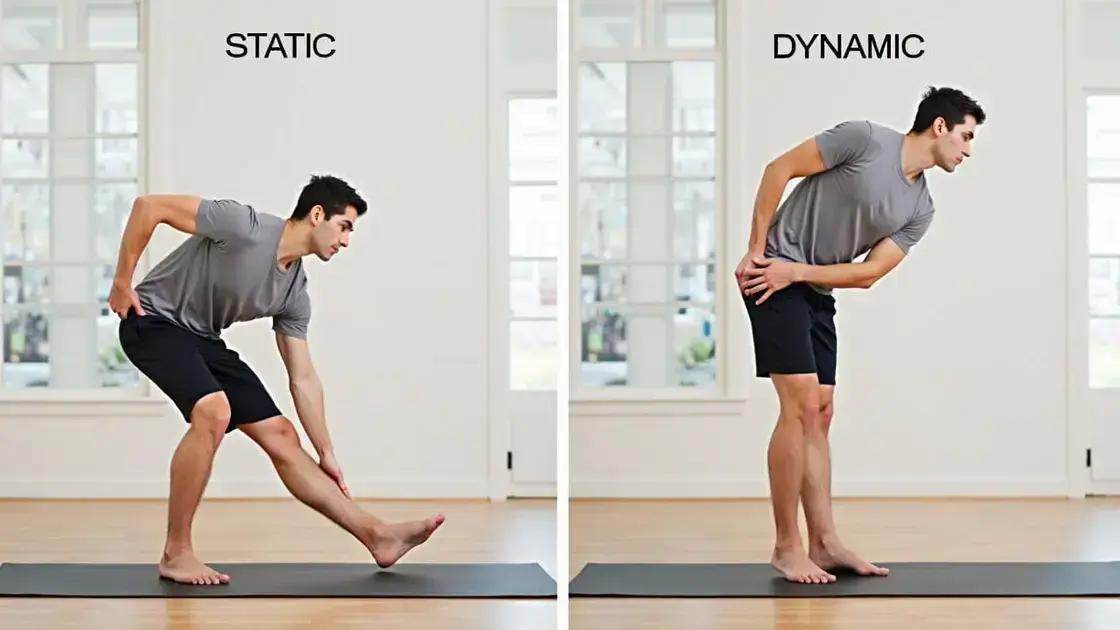To prevent muscle stiffness after long workouts, incorporate effective stretching techniques, stay hydrated, consume a balanced post-workout meal, and engage in active recovery exercises. Regular stretching and flexibility practices like yoga can also enhance your overall performance and minimize soreness.
After a long workout, many people experience muscle stiffness, which can be uncomfortable and hinder future performance. Learning how to prevent muscle stiffness after long workouts is crucial for athletes and fitness enthusiasts alike. In this article, we’ll explore effective stretching techniques, essential recovery tips, and best practices to maintain flexibility. Say goodbye to soreness and hello to a more enjoyable workout experience!
Understanding Muscle Stiffness

Muscle stiffness often occurs after intense physical activity and is a common condition that affects athletes and gym-goers. This stiffness can arise from various factors, including microscopic damage to muscle fibers, the buildup of lactic acid, and inflammation.
What’s Happening to Your Muscles?
During a vigorous workout, muscles undergo stress and strain. This can lead to tiny tears in the muscle tissue. While this process is a normal part of muscle strengthening, it can also result in soreness and stiffness. Understanding the underlying causes is important in preventing discomfort in the future.
Why Muscle Stiffness Occurs
Stiffness can also occur due to the accumulation of metabolic waste, such as lactic acid, which results from energy production during exercise. When workouts are very strenuous, the body may not clear these byproducts quickly enough, leading to that tight feeling in your muscles.
Factors Influencing Stiffness
Several factors influence muscle stiffness, including age, hydration levels, nutrition, and the intensity and duration of exercise. Older adults tend to experience more stiffness because of natural declines in flexibility and muscle elasticity. Additionally, muscles that are not properly warmed up before exercise are more prone to stiffness.
Effective Stretching Techniques

Incorporating stretching techniques into your routine can help reduce muscle stiffness significantly. Here are some effective stretching methods to consider:
1. Static Stretching
This technique involves holding a stretch for a specific period, usually 15 to 30 seconds. For example, if you want to target the hamstrings, sit on the floor and reach towards your toes until you feel a gentle stretch. Always remember to breathe deeply and relax into the stretch.
2. Dynamic Stretching
Dynamic stretching is done before workouts to prepare the muscles. This includes movements like arm circles, leg swings, or walking lunges. These movements gradually increase your heart rate and warm up your muscles, reducing the risk of stiffness.
3. Foam Rolling
Using a foam roller can be an excellent way to loosen tight muscles and improve flexibility. Roll over the tight areas of your body slowly, spending extra time on the most sore spots. This technique helps break down knots and increases blood flow to the muscles.
4. Incorporate Yoga
Practicing yoga can enhance flexibility and reduce stiffness. Poses like Downward Dog, Cat-Cow, and Child’s Pose stretch and strengthen various muscle groups. Additionally, yoga encourages relaxation and deep breathing, which can aid muscle recovery.
Post-Workout Recovery Tips

Recovering properly after a workout is essential for minimizing muscle stiffness and enhancing performance. Here are some effective post-workout recovery tips:
1. Hydration is Key
After exercising, it’s important to rehydrate. Drink water or a sports drink to replenish lost fluids and electrolytes. Staying hydrated helps reduce muscle soreness and maintains overall performance.
2. Refuel with Nutrients
Post-workout nutrition plays a vital role in recovery. Aim to consume a meal or snack that includes both protein and carbohydrates within 30 to 60 minutes after your workout. This helps repair muscle tissues and replenish energy stores.
3. Rest and Sleep
Allow your body adequate time to recover. Getting quality sleep is crucial during this period, as most muscle repair and recovery processes happen while you rest. Aim for 7-9 hours of sleep each night to promote better recovery.
4. Active Recovery
Engaging in light activities such as walking, cycling, or gentle yoga can help alleviate stiffness. Active recovery increases blood flow to the muscles, which can help to flush out toxins and promote healing.
Best Practices to Stay Flexible

To maintain flexibility and prevent stiffness, it’s important to incorporate certain practices into your routine. Here are the best practices to stay flexible:
1. Make Stretching a Habit
Introduce a regular stretching routine, focusing on all major muscle groups. Aim to stretch at least three times a week. Creating a habit of stretching can help maintain elasticity in your muscles and connective tissues.
2. Warm-Up Before Workouts
Engaging in a proper warm-up is essential to prepare your muscles for exercise. A good warm-up increases blood flow, improves muscle elasticity, and reduces the likelihood of stiffness. Spend 5-10 minutes on activities like light jogging or dynamic stretching before your workout.
3. Incorporate Flexibility Training
In addition to regular stretching, consider including flexibility-focused workouts like yoga or Pilates. These practices specifically target and improve overall flexibility, balance, and strength.
4. Listen to Your Body
Pay attention to how your body feels during and after workouts. If you notice tightness or discomfort, address it with stretching or resting. Remember that everyone’s flexibility level is different. Adjust your routines to what feels best for you.
In Summary: Preventing Muscle Stiffness and Enhancing Recovery
Preventing muscle stiffness after long workouts is essential for maintaining fitness and enhancing performance. By understanding the causes of muscle stiffness and applying effective stretching techniques, you can keep your muscles flexible and ready for action.
Additionally, following post-workout recovery tips such as proper hydration, nutrition, and rest ensures that your body heals and rebuilds effectively. Incorporating best practices to stay flexible, such as regular stretching and listening to your body, can set you on the path to more enjoyable workouts.
By implementing these strategies, you’ll minimize stiffness, improve your overall performance, and enjoy your fitness journey more fully.
FAQ – Frequently Asked Questions about Preventing Muscle Stiffness After Long Workouts
What causes muscle stiffness after workouts?
Muscle stiffness can occur due to micro-tears in muscle fibers, lactic acid buildup, and inflammation after intense physical activity.
How can stretching help prevent muscle stiffness?
Stretching before and after workouts increases muscle flexibility, reduces tightness, and promotes blood flow, helping to prevent stiffness.
What are some effective post-workout recovery tips?
Hydrate, refuel with a balanced meal, get enough rest, and consider light activities like walking for active recovery to reduce stiffness.
How often should I stretch to maintain flexibility?
Aim to stretch at least three times a week, incorporating both static and dynamic stretching into your routine for best results.
Is yoga beneficial for preventing muscle stiffness?
Yes, yoga enhances flexibility, strength, and relaxation, which can all help mitigate muscle stiffness and promote overall recovery.
How can I listen to my body during workouts?
Pay attention to any areas of tightness or discomfort and adjust your routine accordingly. If something doesn’t feel right, modify your exercises.












